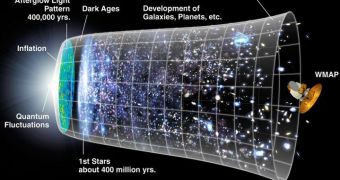A new theory proposes that the earliest Universe, which formed immediately after the Big Bang, expanded in the space around it in an extremely chaotic manner.
This is not by far a new idea. It was proposed for the first time more than seven years ago, by Adilson E. Motter, who is a physics expert at the Northwestern University.
At the time when the idea was first conjectured, the physicist did not have the tools needed to prove it.
Now, with the help of a colleague, Motter finally managed to present the world with the mathematical utensils needed to demonstrate the theory rigorously.
Details of the work appear in a paper entitled “(Non)Invariance of Dynamical Quantities for Orbit Equivalent Flows,” which is published in the latest issue of the top-rated Journal Communications in Mathematical Physics.
The mathematical tools work extremely well when applied to the most widely-accepted model of how the Universe came to be.
The main conundrum the physicist was trying to crack is whether chaos is absolute or relative inside systems that are in themselves governed by general relativity.
In these systems, time itself is relative. For the purpose of the work, chaos was determined at the phenomenon by which tiny events lead to very large changes in the time evolution of a system.
The Universe therefore becomes a prime example of a chaotic system. An absolute thing, for example, is the speed of light, which remains the same regardless of where an observer is placed in time and space.
“A competing interpretation has been that chaos could be a property of the observer rather than a property of the system being observed,” says Motter, who is an assistant professor of physics and astronomy at the Northwestern Weinberg College of Arts and Sciences.
“Our study shows that different physical observers will necessarily agree on the chaotic nature of the system,” adds the expert, who is also the author of the new journal entry.
“Technically, we have established the conditions under which the indicators of chaos are relativistic invariants. Our mathematical characterization also explains existing controversial result,” Motter goes on to say.
“They were generated by singularities induced by the choice of the time coordinate, which are not present for physically admissible observables,” he concludes.

 14 DAY TRIAL //
14 DAY TRIAL //